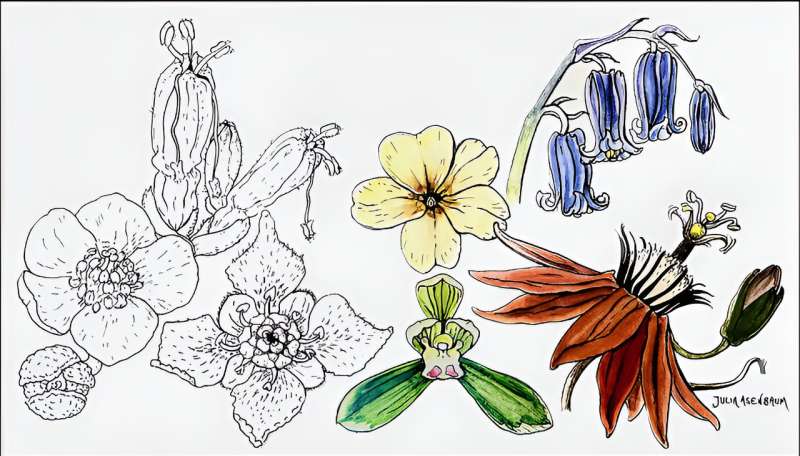Floral time travel: Flowers were more diverse 100 million years ago than they are today

An international team of researchers led by botanists at the University of Vienna, Austria, has analyzed the morphological diversity of fossilized flowers and compared it with the diversity of living species. They found that flowering plants had already produced a large number of different flower types shortly after their emergence in the Cretaceous period, and this earliest floral diversity was greater than that today.
The study has been in the journal New Phytologist.
With at least 300,000 species, flowering plants (angiosperms) are by far the largest group of plants living today. They first appeared at least 140 million years ago, when dinosaurs roamed the Earth.
In recent decades, many fossilized flowers from different geological time periods have been discovered and described, giving us a glimpse of past diversity. But how does this past diversity compare to the present one? And—what has happened to flower morphology over time?
An international research team from the National Autonomous University of Mexico, the Botanic Gardens of Sydney, Australia, and the University of Vienna, Austria, has tackled precisely these questions—and found answers.
More diversity—fewer species
For this study, the researchers examined 30 floral characteristics in 1,201 living and 121 fossil angiosperms to measure floral diversity and to investigate patterns of floral evolution over time and across lineages.
"Interestingly, it turned out that the Early Cretaceous flowers were on average more different from each other than today's flowers, even though there are many more species of flowering plants on Earth today," explains Marion Chartier from the Department of Botany and Biodiversity Research at the University of Vienna.
"Our results are fascinating because we only know a relatively small number of flowers from the Early Cretaceous, but this small number showed more variability than a thousand living species sampled for the study," Andrea López, co-leading author from the National Autonomous University of Mexico, adds.
A similar evolutionary pattern, with a high degree of morphological diversity at a time when the number of species was relatively low, is also known in several animal groups (e.g., dinosaurs or fish).
"For flowering plants, one possible explanation for this pattern is that when the group first evolved, floral organization was more flexible and novel flower types could evolve more easily. This flexibility may have allowed flowering plants, within a few million years of their origin, to adapt to the different animals that pollinated their flowers and dispersed their fruits," explains Dr. Maria von Balthazar from the University of Vienna.
Flower types—evolution knows best
The collection of the vast dataset of floral traits required for this study was made possible by the eFLOWER project, coordinated by Hervé Sauquet of the Botanic Gardens of Sydney and Jürg Schönenberger of the University of Vienna.
"Our analyses clearly show that the morphological diversity of a given group does not necessarily correlate with species richness of that same group. In fact, some of the most species-rich groups of flowering plants, such as orchids and the daisy family, have managed to produce thousands of species while maintaining the same floral organization," Schönenberger states.
But the early diversity in flower morphologies was not the only fascinating finding. The researchers also showed that certain combinations of features were theoretically possible, but apparently never produced by evolution. At the same time, some particularly successful flower types arose independently several times.
"We are excited by these results," explains Dr. Susana Magallón from the National Autonomous University of Mexico. "Our study opens up a new perspective and clearly shows that fossils are crucial to understanding the evolution of flowers."
More information: Andrea M. López‐Martínez et al, Angiosperm flowers reached their highest morphological diversity early in their evolutionary history, New Phytologist (2023).
Journal information: New Phytologist
Provided by University of Vienna




















